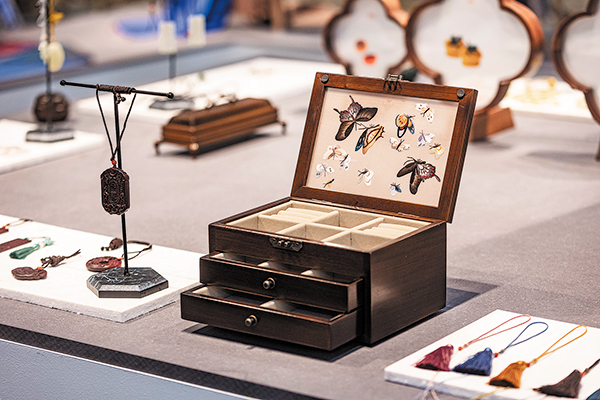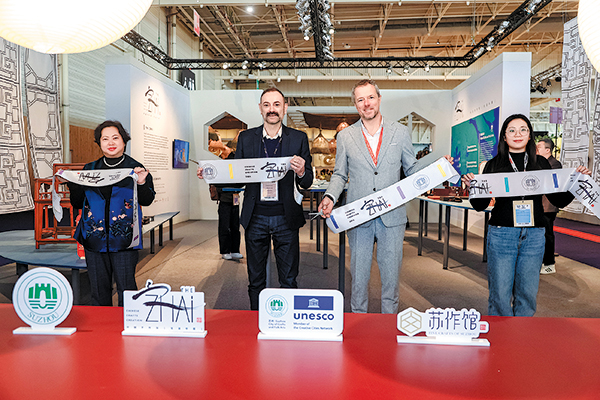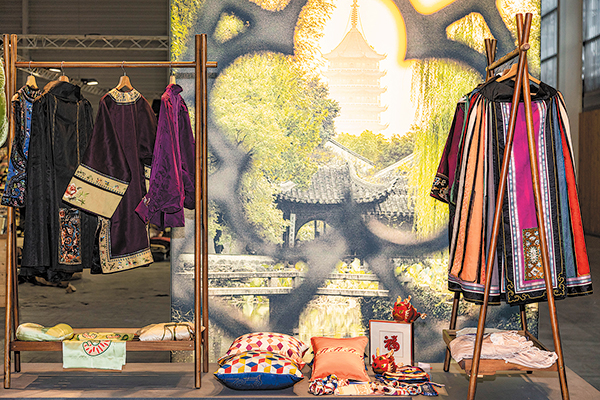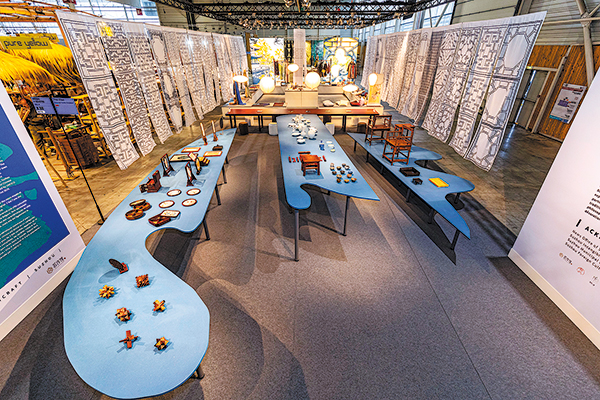Maison & Objet gets a taste of China

The Zhai presents Chinese intangible cultural heritage to the audience in Paris. The exhibition showcases over 200 items from Suzhou, Jiangsu province.
Visitors to January's Maison & Objet in Paris were able to step into a world of elegance and tradition at The Zhai ("house" in Chinese), an exhibition that opened a time-space portal to the water towns of Jiangnan (the region south of the lower reaches of the Yangtze River) through the lens of its handicrafts.
Living testaments of the millennium-old knowledge and craftsmanship passed down by the artisans of Suzhou, Jiangsu province, traditional Chinese craft has now been placed center stage at the renowned international platform.
Based on themes such as "city", "intangible cultural heritage" and "handicraft", The Zhai opened its doors at this year's edition of Maison& Objet Paris between Jan 18 and 22 with a glittering showcase of over 200 time-honored Suzhou crafts.
The museum-style exhibition, which was the first project in a series called "The Zhai", is designed to serve as a dynamic platform for cultural exchange between China and France. It revolves around the concept of "city, home and objects", and makes use of a partner city — with Suzhou as the first — as its starting point.
Maison & Objet Paris is one of the three premier trade show expos in Europe, and is celebrating its 30th anniversary by embracing the theme of "Tech Eden", which addresses the fusion of design and sustainable development in response to technology and the challenges of environmental conservation.
The project responded to this theme by highlighting the harmony between humans and nature, drawing inspiration from the traditional Chinese philosophy of the "unity of heaven and humanity" embedded in traditional craftsmanship, as a way of illustrating Chinese thinking on such matters for future development.

Guests at the opening ceremony of the exhibition on Jan 18 in Paris.
Chinese Ambassador to France Lu Shaye visited the exhibition. After thoroughly examining the display, Lu expressed his wish for the project to build more international connections in the hopes that the project can contribute to the global recognition of China's traditional culture and craftsmanship.
Suzhou is a vital center for preserving traditional craftsmanship. In 2014, it was recognized by UNESCO as the City of Crafts and Folk Art. Suzhou stands out for its diversity and exceptional skills, producing over 3,000 kinds of items in 10 of the 11 main categories of Chinese craftsmanship.
Focusing on craftsmanship and intangible cultural heritage, the items on display came from three traditional craft towns in Suzhou: Guangfu and Shengze, and Zhenhu subdistrict.
Guangfu is known as the "hometown of a hundred crafts", and has a long history and numerous skilled professionals involved in trades such as jade carving, nut carving, and woodcarving. Zhenhu is the main hub for Suzhou-style embroidery, which it has been producing for over 2,000 years. Almost half of its population is involved in the trade. Meanwhile, Shengze has a long-standing reputation for silk production, and its artisans have continued to innovate, giving rise to nationally recognized brands in the silk and textile sector.
All the items displayed were selected during the visit of Francois Delclaux, curator of the exhibition, to Suzhou in November.
Delclaux visited a number of cultural gems, from the Suzhou Museum and the Humble Administrator's Garden, to traditional craft towns like Guangfu and Shengze, and Zhenhu subdistrict.

The Zhai presents Chinese intangible cultural heritage to the audience in Paris. The exhibition showcases over 200 items from Suzhou, Jiangsu province.
The trip deepened his understanding of Suzhou's craftsmanship and cultural heritage. His most significant discovery was that the traditional Chinese craftsmanship will make a mark on the international stage, which was evident in the distinctive qualities he observed in Suzhou.
On the opening day of the exhibition, Delclaux hosted a livestream in which he introduced Taihu Lake, the curatorial source of his inspiration for the exhibition, and also highlighted selected exhibits for a global audience.
"During my time in Suzhou, I was captivated by its long history, delightful culture and remarkable craftsmanship," he says, adding that his aim was to share his experiences with the audience through the exhibition and its curated selection.
Delclaux integrated elements from Suzhou into the space and took into account the tastes of people from different cultural backgrounds to ensure a better alignment with the expectations of the international market.
He says that the exhibition and the project served as a useful way for the international audience to appreciate traditional Chinese craftsmanship, and sees this as a step toward keeping Chinese products up to date.
Looking ahead, he says that he hopes the exhibition will maximize on its brand appeal, create more international connections, and meet the needs of the global market.
During the opening ceremony, Guillaume Prot, show director of Maison & Objet Paris, expressed his pleasure at seeing the debut of Suzhou craftsmanship.
"We welcome more Chinese exhibitors to bring additional inspiration and surprises to the international design stage," Prot says, adding that the presence of Chinese exhibitors not only enhanced the French trade fair's international appeal, but also provided an opportunity to show the allure of Chinese products.

The items on display come from three craft towns in Suzhou: Guangfu, Shengze and Zhenhu subdistrict.
"In 2024, to mark the 60th anniversary of Sino-French diplomatic relations and the 30th anniversary of M & O, we have launched the China Intangible Cultural Heritage design pavilion. It serves as a platform for exhibition and business cooperation between the two countries, and will foster creative design collaborations. We are excited to witness a new chapter in Sino-French cooperation," he says.
Architect and interior designer Sebastien Coudert-Maugendre says that the crafts on display in The Zhai left a profound impression. "The themes, materials, and craftsmanship were something we seldom encounter in the international market. In future projects, I hope to integrate elements of traditional Chinese culture in my designs. I also look forward to collaborating directly with the skilled artisans who create these exquisite crafts," he says.
Jin Yi, head of The Zhai project, says that Suzhou's role as their first partner city has set the bar high for the project's international debut.
"The Zhai is open to collaboration opportunities nationwide for its biennial exhibitions. We invite cities with a rich history of traditional craftsmanship and unique brands like Suzhou to join us on the international stage and in entering the global market," she says.
Jin says that the aim of the project is to blend international design excellence and resources with traditional Chinese craftsmanship and brands, and also to broaden avenues of collaboration, and strengthen ties with brands, retailers and other creative sectors.
Together, the goal is to create products that are innovative, have significant international market potential, and resonate with global consumer trends, she says.
Related articles
-
 Mural artist transforms hometown into rural art gallery
Mural artist transforms hometown into rural art galleryMore
-
 Handmade dolls bring fortunes to local residents in SW China's county
Handmade dolls bring fortunes to local residents in SW China's countyMore
-
 Call of a craft
Call of a craftMore
-
 Experts restore Terracotta Warriors in Xi'an
Experts restore Terracotta Warriors in Xi'anMore
-
 Terracotta artist rekindles lost light on ancient skills
Terracotta artist rekindles lost light on ancient skillsMore
-
 Rattan weaving brings prosperity to people in Hanzhong, NW China's Shaanxi
Rattan weaving brings prosperity to people in Hanzhong, NW China's ShaanxiMore
